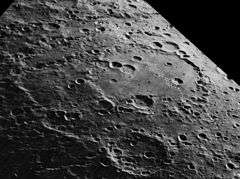Hertzsprung (crater)
|
Oblique Lunar Orbiter 5 image | |
| Coordinates | 1°22′N 128°40′W / 1.37°N 128.66°WCoordinates: 1°22′N 128°40′W / 1.37°N 128.66°W |
|---|---|
| Diameter | 570 km (350 mi)[1] |
| Depth | Unknown |
| Colongitude | 140° at sunrise |
| Eponym | Ejnar Hertzsprung |

Hertzsprung is an enormous lunar crater, or impact basin, that is located on the far side of the Moon, beyond the western limb. In dimension, this formation is larger than several of the lunar mare areas on the near side. It lies in the northwestern fringe of the blast radius of the Mare Orientale impact basin. Nearby craters of note include Michelson across the northeast rim, Vavilov across the western rim, and Lucretius to the southeast.
The outer rim of Hertzsprung has been damaged and modified by several notable impacts (mentioned above) and a number of smaller craters. A chain of small craters, designated Catena Lucretius, begins at the southeastern outer rim and proceeds toward the west-northwest until it connects with the perimeter of the inner basin. This inner area is less rough than the outer ring of the floor, and is surrounded by a circular range of ridges. The inner perimeter is also pierced by several craters, including Hertzsprung D along the eastern portion and Hertzsprung S on the western side. Nor is the interior of the inner basin free from impacts, including K, H, X, and L, listed in the table below.
At the center of the basin is a mass concentration (mascon), or gravitational high. The mascon was first identified by Doppler tracking of the Lunar Prospector spacecraft.[2]
The equator of the Moon passes through this formation, being located to the south of the midpoint and cutting through the central basin.
.jpg) Topographic map
Topographic map Gravity map based on GRAIL
Gravity map based on GRAIL
Satellite craters
By convention these features are identified on lunar maps by placing the letter on the side of the crater midpoint that is closest to Hertzsprung.
| Hertzsprung | Coordinates | Diameter, km |
|---|---|---|
| D | 3°26′N 126°12′W / 3.43°N 126.20°W | 48 |
| H | 1°16′S 125°09′W / 1.26°S 125.15°W | 20 |
| K | 0°40′S 128°29′W / 0.67°S 128.48°W | 27 |
| L | 0°13′N 128°42′W / 0.22°N 128.70°W | 35 |
| M | 7°33′S 129°47′W / 7.55°S 129.79°W | 36 |
| P | 0°08′S 130°14′W / 0.14°S 130.24°W | 22 |
| R | 0°16′S 132°48′W / 0.27°S 132.80°W | 30 |
| S | 0°27′N 133°24′W / 0.45°N 133.40°W | 49 |
| V | 5°04′N 134°10′W / 5.07°N 134.17°W | 40 |
| X | 3°41′N 130°05′W / 3.68°N 130.08°W | 24 |
| Y | 8°46′N 131°59′W / 8.77°N 131.99°W | 25 |
References
- ↑ Stockstill, K. R.; Spudis, P. D. (March 16–20, 1998). Geology and Deposits of the Hertzsprung Basin, Lunar Far Side (PDF). 29th Annual Lunar and Planetary Science Conference. Houston, TX (published March 1998). Bibcode:1998LPI....29.1236S.
- ↑ A. S. Konopliv; A. B. Binder; L. L. Hood; A. B. Kucinskas; W. L. Sjogren & J. G. Williams (1998). "Improved Gravity Field of the Moon from Lunar Prospector". Science. 281 (5382): 1476–1480. Bibcode:1998Sci...281.1476K. doi:10.1126/science.281.5382.1476. PMID 9727968.
- Andersson, L. E.; Whitaker, E. A. (1982). NASA Catalogue of Lunar Nomenclature. NASA RP-1097.
- Blue, Jennifer (July 25, 2007). "Gazetteer of Planetary Nomenclature". USGS. Retrieved 2014-12-10.
- Bussey, B.; Spudis, P. (2004). The Clementine Atlas of the Moon. New York: Cambridge University Press. ISBN 978-0-521-81528-4.
- Cocks, Elijah E.; Cocks, Josiah C. (1995). Who's Who on the Moon: A Biographical Dictionary of Lunar Nomenclature. Tudor Publishers. ISBN 978-0-936389-27-1.
- McDowell, Jonathan (July 15, 2007). "Lunar Nomenclature". Jonathan's Space Report. Retrieved 2007-10-24.
- Menzel, D. H.; Minnaert, M.; Levin, B.; Dollfus, A.; Bell, B. (1971). "Report on Lunar Nomenclature by the Working Group of Commission 17 of the IAU". Space Science Reviews. 12 (2): 136–186. Bibcode:1971SSRv...12..136M. doi:10.1007/BF00171763.
- Moore, Patrick (2001). On the Moon. Sterling Publishing Co. ISBN 978-0-304-35469-6.
- Price, Fred W. (1988). The Moon Observer's Handbook. Cambridge University Press. ISBN 978-0-521-33500-3.
- Rükl, Antonín (1990). Atlas of the Moon. Kalmbach Books. ISBN 978-0-913135-17-4.
- Webb, Rev. T. W. (1962). Celestial Objects for Common Telescopes (6th revised ed.). Dover. ISBN 978-0-486-20917-3.
- Whitaker, Ewen A. (2003). Mapping and Naming the Moon. Cambridge University Press. ISBN 978-0-521-54414-6.
- Wlasuk, Peter T. (2000). Observing the Moon. Springer. ISBN 978-1-85233-193-1.
